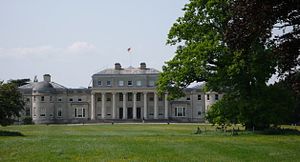Shugborough
| Shugborough Hall | |
|---|---|

|
|
|
Location within Staffordshire
|
|
| General information | |
| Architectural style | Neo-Classical, Italianate |
| Location | Great Haywood, Staffordshire |
| Country | England |
| Coordinates | 52°48′00″N 2°00′47″W / 52.80005°N 2.01295°WCoordinates: 52°48′00″N 2°00′47″W / 52.80005°N 2.01295°W |
| Owner |
National Trust, Earl of Lichfield (formerly) |
| Design and construction | |
| Architect | Thomas Wright Samuel Wyatt James Stuart |
| Website | |
| www |
|
Shugborough Hall is a stately home near Great Haywood, Staffordshire, England.
The hall is situated on the edge of Cannock Chase, about 4 miles (6.4 km) east of Stafford. The estate was owned by the Bishops of Lichfield until the Dissolution of the Monasteries, upon which it passed through several hands before being purchased in 1624 by William Anson, a local lawyer and ancestor of the Earls of Lichfield. The estate remained in the Anson family for three centuries. Following the death of the 4th Earl of Lichfield in 1960, the estate was allocated to the National Trust in lieu of death duties, and then immediately leased to Staffordshire County Council. Management of the estate was returned to the National Trust in 2016. It is open to the public and comprises the hall, museum, kitchen garden and a model farm.
The Shugborough estate was owned by the Bishops of Lichfield until the Dissolution of the Monasteries around 1540 and thereafter passed through several hands until it was purchased in 1624 by William Anson, a lawyer, of Dunston, Staffordshire for £1,000. In 1693, William Anson's grandson, also called William, demolished the existing manor house and constructed a three-story building which stills forms the central part of the hall.
William's elder son, Thomas Anson MP (1695-1773), would further extend the house in the 1740s, adding two pavilions flanking either side of the central block. It was Thomas's younger brother, however, who would fund these changes; Admiral George Anson, created Lord Anson in 1747 and First Lord of the Admiralty in 1751, amassed a great fortune during his naval career and when he died without issue he left the majority to his elder brother. Thomas also died childless and the estate passed to his sister's son, George Adams, who adopted the surname Anson by royal licence.
...
Wikipedia

